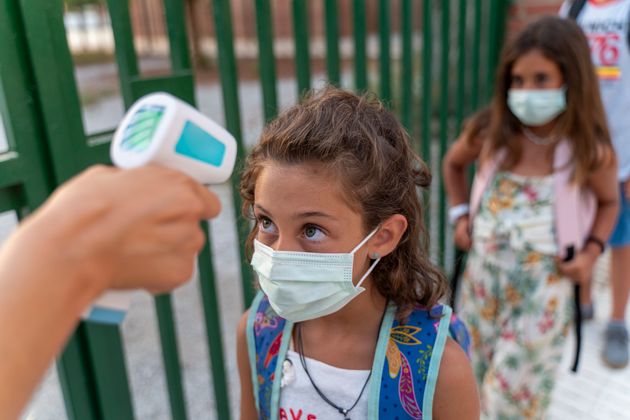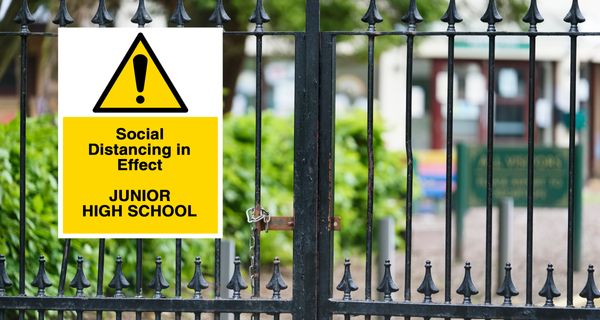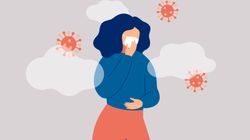If you’ve got a primary school-aged child, chances are you’re now used to a weird ‘new normal’ – one which involves watching them pass through a temperature gun check before they’re allowed in to lessons.
It still feels a bit mind-boggling not being able to mingle in the playground after a lengthy six months without playdates, or casual chats with parent pals, but we all understand the stakes, especially now that Boris Johnson has confirmed England will go into national lockdown once again.
At my children’s school in east London, the headteacher has gone a long way to alleviate parental concern over coronavirus – sending dozens of emails to lay out the measures the school has been taking to keep students and teachers safe – including a recent plea for people to ensure they keep their children at home if they have any of the key symptoms, and not to be late so the school can maintain a safe and staggered start.
He’s even asked parents to avoid bringing forgotten items into the school office. “Sorry if that sounded like a moan,” he wrote. “These are just tweaks that we need to get right for everyone if we are to keep everyone as safe as possible.”

It all helps, both to keep everyone safe and to alleviate the understandable anxiety among parents.
Psychotherapist and author Joshua Fletcher, who runs The Panic Room counselling service in Manchester, recently told HuffPost UK he had seen a spike in anxiety-related queries from clients as a result of Covid-19, particularly when lockdown measures were lifted and the rules became blurred and more confusing. People became more anxious when “they didn’t have the rigid guidelines to fall back on”, he said.
If your source of anxiety is your children’s school and how it’s keeping pupils and teachers safe, it might be helpful to take a look at the government website, which lays out the precautions all educational settings should be following.
HuffPost UK also spoke to a Department of Education spokesperson, who said that while there “cannot be a ‘one-size-fits-all’ approach” that fits every scenario, the government has included in its guidelines measures for schools to engage with parents.
“School leaders will be best placed to understand the needs of their schools and communities and to make informed judgments about how to balance delivering a broad and balanced curriculum with the measures needed to manage risk,” the spokesperson said. “The system of controls provides a set of principles to help them do this and, if schools follow this advice and maximise the use of control measures, they will effectively minimise risks.”
She said the government expects schools to work closely with parents, staff and unions – and to discuss openly with parents and staff when personal circumstances, such as being clinically vulnerable, created extra concerns.
“We want all pupils and staff to be back in schools, and believe the conditions are right for this, but some people will understandably have worries that should be heard and addressed.”

If you’re confused, concerned, or think you’ve seen something in your children’s school that doesn’t meet the safety guidelines, the best advice is to talk to your school directly. Here are the eight key areas you could ask teachers about:
Health checks
Schools may check kids for symptoms of coronavirus each day. This can include temperature checks and questions about possible symptoms. If someone gets sick, the school should have a process for isolating them, reporting possible exposure to infection, and a timeline of when they can return to school.
Social distancing
Staff are still advised to keep 1m away from children and other staff, as per government advice. A study by Public Health England about schools reopening in June found staff members were more likely to be affected by the virus than students, though not more likely than the general population as a whole
Bubbles
Given how hard it is to get young children to keep apart, classes are now generally grouped together in ‘bubbles’. In some cases, especially where numbers are low, two year groups may be put into one bubble so they can interact with each another.
Face coverings
In August, the World Health Organisation published a statement about children and face coverings. It advises that “children aged 12 and over should wear a mask, like adults, when they cannot guarantee at least a 1m distance from others”. However, the UK government is not recommending face coverings to be worn in education settings generally. Instead, schools and colleges have the discretion to require face coverings in indoor communal areas where social distancing cannot be safely managed, if they believe it is necessary.
Lunchtimes
Lunch breaks might be staggered in some schools to enable students to get their lunch safely – and without mixing with other classes and bubbles.
Hand washing
Students and staff should wash their hands with soap and water well and often. Hand sanitiser should be readily available as well as access to hand basins.
Cleaning and disinfecting
Cleaning and disinfecting common areas is advised by the Centers for Disease Control (CDC). Surfaces that get touched a lot (such as bathroom handles and knobs, keyboards, and doorknobs) should be cleaned as often as possible.
If there’s an outbreak
Ask your school what their plan is if there’s a Covid-19 outbreak – and how they plan to control it. Also ask how parents or carers will be notified: by email, text or call? If children are sent home on isolation, find out what the plan is for full-time distance learning.
Lastly…
Remind yourself that kids are less likely to catch and spread the coronavirus than adults. A school with good safeguards in place helps protect students and lowers their chances of getting ill. And if healthy children do get the virus, they are less likely than adults to show symptoms – or to get very sick.



